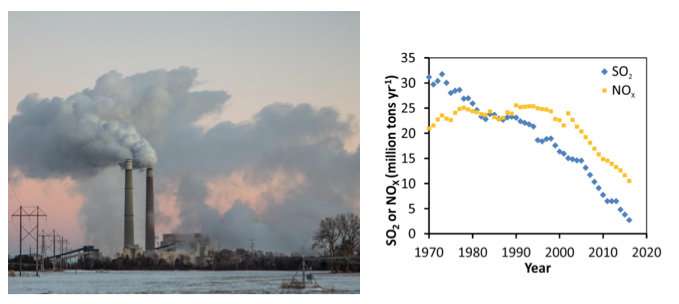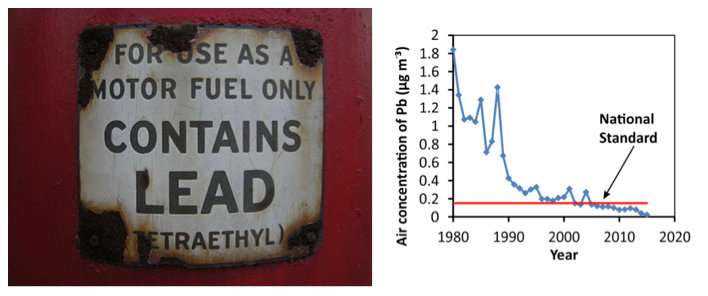Long-term monitoring is essential to effective environmental policy

Environmental policy guided by science saves lives, money, and ecosystems. So reports a team of eleven senior researchers in Environmental Science & Policy. Using air pollution in the United States as a case study, they highlight the success of cleanup strategies backed by long-term environmental monitoring.
Co-author Gary Lovett, a Senior Scientist at the Cary Institute of Ecosystem Studies, comments, "In an era where science faces skepticism, we came together to highlight measurable improvements to air and water quality made possible by legislation backed and tracked by environmental monitoring."
"When it comes to sound environmental policy, facts and data matter. Our efforts to curtail harmful emissions in the US have been guided and validated by environmental monitoring. Reduced air pollution has had tremendous environmental, social, and economic benefits," explains lead author Timothy Sullivan of E&S Environmental Chemistry Inc.
Air pollution has been linked to illness and premature death. When it falls on forests and freshwaters, it also compromises habitat, water quality, and ecosystem services. Reducing air pollution is good for our health and keeps industries like forestry, tourism, and fisheries viable.
Across the US, the quality of air and freshwater has vastly improved in recent decades, mainly due to the Clean Air and Clean Water Acts enacted nearly 50 years ago.

Since the 1970s, monitoring sites have recorded declining concentrations of airborne pollutants such as sulfur, nitrogen, mercury, and lead. Precipitation has become less acidic, improving water quality in lakes and streams. Visibility-limiting haze and concentrations of ground-level ozone have also decreased.
Improvements in ecosystem health associated with legislation include reductions in:
- Acidification: Fossil fuel combustion and other emissions sources release sulfur and nitrogen into the atmosphere. When these pollutants are deposited on the landscape, they can acidify soil and surface waters. Acidification degrades ecosystems; harms vegetation, fish, and wildlife; and threatens water quality. Nitrogen further compromises freshwaters by fueling algal and cyanobacterial blooms that can result in water toxicity and low-oxygen conditions that are unsuitable for aquatic life.
The National Atmospheric Deposition Program, established in response to the Clean Air Act, measures concentrations of sulfur and nitrogen in precipitation at 270 monitoring sites across the US. These records show that total sulfur and nitrogen deposition has decreased by more than half since monitoring began in the 1980s.
- Mercury: Sources of mercury emissions include power plants, incinerators, industry, mining, and biomass burning. When mercury enters surface waters, it is passed up the food chain. Through 'bioaccumulation', mercury can reach toxic levels in fish, posing a health threat to humans and wildlife who eat contaminated fish. In the US, mercury emissions peaked in the 1980s and are in steady decline.
- Lead: Lead causes neurological damage in children and cardiovascular effects in adults. Regulations requiring the removal of lead-based fuel additives from gasoline have led to a dramatic decline (>95%) in lead concentrations in the air.
- Haze: Gases and airborne particulate matter create haze and reduce visibility. Human-generated sulfur emissions are the primary cause of haze in the eastern US; smoke from wildfires is one of the top contributors in the west. The Regional Haze Rule (1999) requires states to reduce haze to a 'natural background' in protected 'Class 1' national parks and wilderness areas. Several eastern national parks have already reported significant declines, in some cases well ahead of stipulated benchmarks.
- Ozone: Ozone is a greenhouse gas that harms vegetation and human health. As part of the Clean Air Act, the National Ambient Air Quality Standard was created to limit the amount of ozone in ground-level air. Ozone concentrations recorded in many protected areas are decreasing and are now below the standard.

The authors highlight the importance of monitoring programs in evaluating the success or failure of environmental policies. Gene Likens, President Emeritus of the Cary Institute of Ecosystem Studies and a Distinguished Research Professor at the University of Connecticut, Storrs explains, "Monitoring programs throughout the US keep a finger on the pulse of shifting environmental conditions. They help us track the effectiveness of pollution reduction policies, and they provide the data needed to recalibrate strategies if they are not working."
Likens established the Hubbard Brook Ecosystem Study, one of the longest running environmental monitoring programs in the US. Since 1963, the program has recorded precipitation and stream water chemistry in the White Mountains of New Hampshire. Data from the study provided the evidence needed to link air pollution to fossil fuel combustion, and informed the 1990 Clean Air Act Amendments. The site is currently a part of the National Science Foundation's Long Term Ecological Research Network.
To date, economic benefits of the Clean Air Act far outweigh costs. Co-author Dallas Burtraw, a Senior Fellow at Resources for the Future, reports, "Improved human health and reduced mortality between 1970 and 1990 provided an estimated $22 trillion benefit to the US economy - at a cost of only 2-3% of that total benefit. By 2020, the 1990 Clean Air Act Amendments are projected to yield an additional $2 trillion in benefits, at an estimated cost of about 3% of that benefit."
Coauthor James Galloway, Sidman P. Poole Professor in the Department of Environmental Sciences at the University of Virginia, notes, "We need to apply lessons from these air pollution success stories to rising greenhouse gases. This includes using evidence-based decision-making to track improvements, avoid reversals, and identify emerging threats."
Charles Driscoll, a coauthor and University Professor of Environmental Systems Engineering at Syracuse University, concludes, "Despite recent and substantial improvements in air pollution, challenges remain. Ammonia levels are still high and legacy effects of air pollution, like soil acidification, persist for decades. Continued long-term environmental monitoring is needed to track recovery and guide future policy crafted in the interest of people, our economy, and the environment."
More information: Timothy J. Sullivan et al. Air pollution success stories in the United States: The value of long-term observations, Environmental Science & Policy (2018). DOI: 10.1016/j.envsci.2018.02.016
Provided by Cary Institute of Ecosystem Studies

















